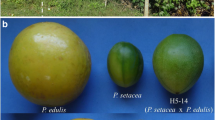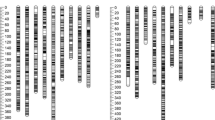Abstract
We have used a one-way pseudo-testcross mapping strategy in combination with different types of PCR-based markers (RAPD, AFLP, SAMPL) to construct a first linkage map for variegated chicory (Cichorium intybus L. var. silvestre Biskoff, n=9), a self-incompatible vegetable species. The success of such a strategy depends on the presence of sufficiently high levels of heterozygosity in the individual plant which is being mapped and on the informativeness of the marker system that is used. A total of 371 markers, comprising 16 RAPDs, 72 SAMPLs and 283 AFLPs, were scored in 46 F1 individuals obtained from an interspecific cross between a C. intybus outbred individual and a C. endivia inbred line. Grouping of the markers at a LOD score of 4.0 resulted in 13 linkage groups covering 1330 cM. A framework map covering 1201.4 cM was assembled by using all markers that could be ordered with a LOD greater than 2.0. We estimate the total genome size of chicory to be ca. 1405 cM, thus considerably smaller than that estimated for lettuce (1950 cM). The usefulness of the different marker systems that were applied is analysed in terms of level of heterozygosity and marker index, i.e. number of different genetic loci that may be simultaneously analysed per experiment. Out of the 371 markers, 50 of them showed segregation distortion which is discussed in terms of the hybrid origin of the variegated chicory.
Similar content being viewed by others
References
Bannerot H, De Coninck B: L'utilisation des hybrides F1 pour l'amélioration de la chicorée de Bruxelles. Symposium sur la Chicorée de Bruxelles, Gembloux, pp. 99–118 (1970).
Bianchedi A: I radicchi di Treviso: storia, coltivazione, forzatura e commercio. Ital Agric 98: 37–51 (1961).
De Lorenzo F: Le cicorie trevigiane. Canova, Treviso (1957).
Doyle JJ, Doyle JL: Isolation of plant DNA from fresh tissue. Focus 12: 13–15 (1987).
Eenink AH: Compatibility and incompatibility in witloof-chicory (Cichorium intybus L.). 1. The influence of temperature and plant age on pollen germination and seed production. Euphytica 30: 71–76 (1981).
Fritsch P, Riesberg LH: High outcrossing rates maintain male and hermaphrodite individuals in populations of the flowering plant Datisca glomerata. Nature 359: 633–636 (1992).
Grattapaglia D, Sederoff R: Genetic linkage maps of Eucalyptus grandis and Eucalyptus urophylla using a pseudo-testcross: mapping strategy and RAPD markers. Genetics 137: 1121–1137 (1994).
Hulbert SH, Ilot TW, Legg EJ, Lincoln SE, Lander ES, Michelmore RW: Genetic analysis of the fungus, Bremia lactuceae, using restriction fragment length polymorphisms. Genetics 120: 947–958 (1987).
Kesseli RV, Paran I, Michelmore RW: Analysis of a detailed genetic linkage map of Lactuca sativa constructed from RFLP and RAPD markers. Genetics 136: 1435–1446 (1994).
Lander ES, Green P, Abrahamson J, Baarlow A, Daly MJ, Lincoln SE, Newburg L: Mapmaker: An interactive computer package for constructing primary linkage maps of experimental and natural populations. Genomics 1: 174–181 (1987).
Landry BS, Kesseli RV, Farrara B, Michelmore RW: A genetic map of lettuce (Lactuca sativa L.) with restriction fragment length polymorphism, isozyme, disease resistance and morphological markers. Genetics 116: 331–337 (1987).
Michelmore RW, Paran I, Kesseli RV: Identification of markers linked to disease resistance genes by bulked segregant analysis: a rapid method to detect markers in specific genomic regions using segregating populations. Proc Natl Acad Sci USA 88: 9828–9832 (1991).
Moore G, Gale MD, Kurata N, Flavell RB: Molecular analysis of small grain cereal genomes: current status and prospects. Bio/technology 11: 584–589 (1993).
Morgante M, Vogel J: Compound microsatellite primers for the detection of genetic polymorphisms. US Patent Appl 08/326456 (1994).
Mullis K, Faloona S, Scharf S, Saiki R, Horn G, Erlich H: Specific enzymatic amplification of DNA in vitro: the polymerase chain reaction. Cold Spring Harbor Symp Quant Biol 51: 263–273 (1986).
O'Brien SJ: Genetic Maps, Book 6: Plants. Cold Spring Harbor Laboratory Press, Cold Spring Harbor, NY (1993).
Olivieri AM, Parrini P: Some breeding aspects in Italian types of Cichorium spp. Proceedings Eucarpia Meeting on Leafy Vegetables, Littlehampton, pp. 12–25 (1980).
Powell W, Morgante M, Andre C, Hanafey M, Vogel J, Tingey SV, Rafalski JA: The utility of RFLP, RAPD, AFLP and SSR markers for germplasm analysis in soybean. Mol Breed 2: 225–238 (1996).
Rafalski JA, Vogel JM, Morgante M, Powell W, Tingey SV: Generating and using DNA markers in plants. In: Birren B, Lai E (eds) Non-mammalian Genomic Analysis: A Pratical Guide, pp. 75–134. Academic Press, New York (1996).
Reynaerts A, Van de Wiele H, De Sutter G, Janssens J: Engineered genes for fertility control and their application in hybrid seed production. Sci Hort 55: 125–139 (1993).
Rick CM: Hybridization between chicory and endive. J Am Soc Hort Sci 61: 459–466 (1953).
Rieseberg LH, Choi H, Chan R, Spore C: Genomic map of a diploid hybrid species. Heredity 70: 285–293 (1993).
Ritter E, Gebhardt C, Salamini F: Estimation of recombinant frequencies and construction of RFLP linkage maps in plants from crosses between heterozygous parents. Genetics 125: 645–654 (1990).
Vos P, Hogers R, Bleeker M, Reijans M, van de Lee T, Hornes M, Frijters A, Pot J, Peleman J, Kuiper M, Zabeau M: AFLP: a new technique for DNA fingerprinting. Nucl Acids Res 23: 4407–4414 (1995).
Zabeau M, Vos P: Selective restriction fragment amplification: a general method for DNA fingerprinting. European Patent Appl 92402629 (Publ Number 0 534 858 A1) (1993).
Williams JGK, Kubelik AR, Livak KJ, Rafalski JA, Tingey SV: DNA polymorphism amplified by arbitrary primers are useful as genetic markers. Nucl Acids Res 18: 6531–6535 (1990).
Author information
Authors and Affiliations
Rights and permissions
About this article
Cite this article
De Simone, M., Morgante, M., Lucchin, M. et al. A first linkage map of Cichorium intybus L. using a one-way pseudo-testcross and PCR-derived markers. Molecular Breeding 3, 415–425 (1997). https://doi.org/10.1023/A:1009616801404
Issue Date:
DOI: https://doi.org/10.1023/A:1009616801404




